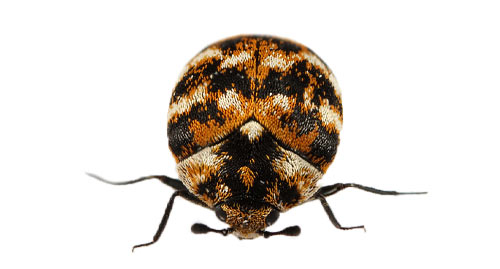Carpet Beetles
Carpet beetles are a very common pest in the Pacific Northwest. Although commonly mistaken for a bed bug, the carpet beetle is on average ⅛ inch long and comes in a variety of shapes and colors. The four most commonly encountered carpet beetles are the black carpet beetle, the varied carpet beetle, the common carpet beetle, and the furniture beetle. Of these, the black carpet beetle causes the greatest damage to fabrics. Carpet beetles are most damaging in the larvae stage. They will eat and shred your upholstery, clothes, and any fabrics in your home they infest.

General Information
Females lay 25 to 100 carpet beetle eggs, which hatch into larvae within two weeks. Larvae are about 1/8 of an inch long and are found in groups covered in tiny hairs. Carpet beetle larvae shed their skins frequently and you will find the light brown shed skins in the same places where the larvae are feeding. Look on the underside or deep in the pile of carpets to find the larvae. Fully grown larvae are about ¼-inch long, yellow-brown, covered with bristly hairs, and fairly active.
Larvae are most likely seen on walls, along baseboards, or on counters. The larvae are responsible for damage to household items. They feed on a wide variety of materials including hair, fur, feathers, hides, horns, carcasses, dead insects, cereal, stored grain, nuts, seeds, spices, and flour.
As the larvae tend to wander from room to room, the infestation can spread throughout the house. Carpet beetles can come from abandoned nests of birds, yellow jackets, or wasps, or even from dead animals. As such, serious infestations of carpet beetles can develop undetected in a home, causing significant damage to clothing, bedding, floor coverings, and other articles. Unlike moths, they tend to munch in large clumps, so the damage can end up being quite noticeable. They can ruin your floor coverings, leaving slits and holes in woven materials or shaving the nap off carpets.
Depending on food sources and climate, carpet beetle larvae may take over a year to develop into adults. After the larvae pupate, the adult beetle emerges and, since it is attracted to light, it heads for windows or lights. It can be seen crawling up light-colored walls or flying to light, trying to get outside. The adult beetles do not cause damage.
The best way to tell carpet beetle damage from clothes moth damage is to look for shed skins left behind by carpet beetle larvae.
Carpet beetles prefer to live and breed in dark, undisturbed areas, including:
- Closets
- Attics along and under carpet edges
- Underneath upholstered furniture
- In boxes where woolens and furs are stored
How Altus Pest Control Can Get Rid of Carpet Beetle
Carpet beetle infestations tend to go unnoticed for long periods of time, allowing them to cause severe damage to bedding, clothes, pillows, carpets and upholstered furniture. Their presence is usually noted from their shed skin, fecal pellets, and larvae.
Just exterminating the pests that are visible to the eye is not enough. Unless you are trying to exterminate pests at the source and take the preventative measures necessary to stop them from entering your home in the first place, you should expect the pests to return.
Carpet beetle’s habitats include nests of birds, rodents, insects, spiders, wasps, or even in cut-flowers. They can use these avenues as carriers into your home. It is common when treating for carpet beetles to need to address one of these other pest issues at the same time.
Unlike other fabric pests such as clothes moths, carpet beetle larvae are very adventurous and may crawl from one apartment to another. As such, it is recommended that an infestation be controlled as soon as it is identified.
We offer carpet beetle treatment for all types of carpet bugs and carpet beetles. Altus Pest control can provide an inspection to identify the source of your issue and customized treatment plan to eliminate the infestation for a long-term solution. We are environmentally conscious and commited to using eco-friendly pest control products.
Talk with an expert pest control technician (541) 709-5033
